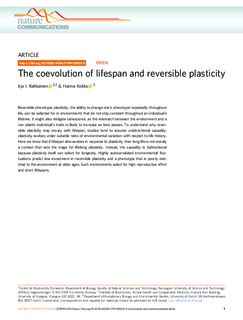| dc.contributor.author | Ratikainen, Irja Ida | |
| dc.contributor.author | Kokko, Hanna | |
| dc.date.accessioned | 2019-02-11T08:12:37Z | |
| dc.date.available | 2019-02-11T08:12:37Z | |
| dc.date.created | 2019-02-10T11:12:50Z | |
| dc.date.issued | 2019 | |
| dc.identifier.citation | Nature Communications. 2019, 10 (538), . | nb_NO |
| dc.identifier.issn | 2041-1723 | |
| dc.identifier.uri | http://hdl.handle.net/11250/2584681 | |
| dc.description.abstract | Reversible phenotypic plasticity, the ability to change one’s phenotype repeatedly throughout life, can be selected for in environments that do not stay constant throughout an individual’s lifetime. It might also mitigate senescence, as the mismatch between the environment and a non-plastic individual’s traits is likely to increase as time passes. To understand why reversible plasticity may covary with lifespan, studies tend to assume unidirectional causality: plasticity evolves under suitable rates of environmental variation with respect to life history. Here we show that if lifespan also evolves in response to plasticity, then long life is not merely a context that sets the stage for lifelong plasticity. Instead, the causality is bidirectional because plasticity itself can select for longevity. Highly autocorrelated environmental fluctuations predict low investment in reversible plasticity and a phenotype that is poorly matched to the environment at older ages. Such environments select for high reproductive effort and short lifespans. | nb_NO |
| dc.description.abstract | The coevolution of lifespan and reversible plasticity | nb_NO |
| dc.language.iso | eng | nb_NO |
| dc.publisher | Nature Research | nb_NO |
| dc.relation.uri | https://www.nature.com/articles/s41467-019-08502-9 | |
| dc.rights | Navngivelse 4.0 Internasjonal | * |
| dc.rights.uri | http://creativecommons.org/licenses/by/4.0/deed.no | * |
| dc.title | The coevolution of lifespan and reversible plasticity | nb_NO |
| dc.type | Journal article | nb_NO |
| dc.type | Peer reviewed | nb_NO |
| dc.description.version | publishedVersion | nb_NO |
| dc.source.pagenumber | 7 | nb_NO |
| dc.source.volume | 10 | nb_NO |
| dc.source.journal | Nature Communications | nb_NO |
| dc.source.issue | 538 | nb_NO |
| dc.identifier.doi | https://doi.org/10.1038/s41467-019-08502-9 | |
| dc.identifier.cristin | 1675370 | |
| dc.relation.project | Norges forskningsråd: 240008 | nb_NO |
| dc.relation.project | Norges forskningsråd: 223257 | nb_NO |
| dc.description.localcode | © The Author(s) 2019 | nb_NO |
| cristin.unitcode | 194,66,10,0 | |
| cristin.unitname | Institutt for biologi | |
| cristin.ispublished | true | |
| cristin.fulltext | original | |
| cristin.qualitycode | 2 | |

